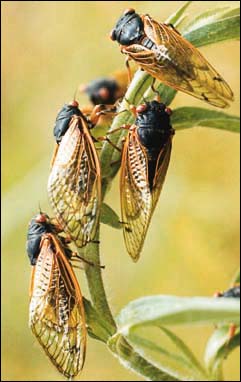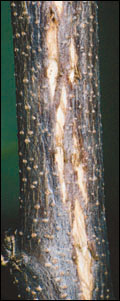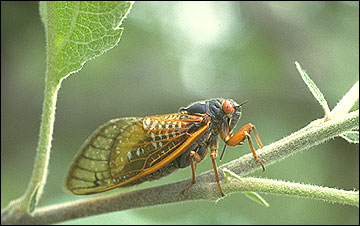The range of periodical cicadas, Magicicada spp. (Figure 1), covers most of the United States east of the Mississippi River and includes Kansas, Oklahoma, Missouri, Texas, Arkansas and Louisiana. Periodical cicadas lay their eggs on numerous tree species, favoring oaks, hickory, honeylocust, hawthorn, dogwood, apple, peach, pear, elm, ash, walnut and sycamore. Conifers appear to be free of attack.

 Figure 1
Figure 1
Periodical cicadas.
Figure 2
Egg slits on twig.
Lee Jenkins Slide Collection
Damage
The adult female cicada uses a sawlike ovipositor to cut through the bark of twigs and branches, preferring those less than 1 inch in diameter, and forms a pocket in the wood where she inserts her eggs (Figure 2). She then will move forward, cutting a new pocket, and lay more eggs. This process may be repeated several times and may produce a continuous slit along the length of the twig. Leaves of the attacked branch can wither and turn brown, and smaller infested branches may break off the following year. Such damage can be serious to young transplanted trees in nurseries and orchards.
Biology
Cicadas are heavy-bodied, wedge-shaped insects that have large compound eyes and membranous wings held rooflike over the body. Periodical cicada adults range from 0.75 to 1.5 inches in length. They have a brownish-black body, unspotted from the top, and reddish colored eyes, legs and wing veins. They have a 13-year or 17-year life cycle.
After hatching, the nymphs drop from the twigs to the ground, enter the soil and begin feeding on sap from the roots. A nymph will remain underground at a depth of 2 to 18 inches until it is ready for its last molt. Before its final molt to the adult stage, the nymph will emerge from the ground, leaving a finger-sized round hole, and climb up the trunk of a tree, fence post or side of a house and attach itself with its claws. The exoskeleton will split down the middle of the back and the adult will gradually pull itself free, leaving the cast skin still attached to the substrate. The adults can live from five to six weeks.
Occasionally, the cicada nymph, just prior to its emergence, will construct earthen chimneys or towers above the soil surface. These towers are about 2--4 inches tall with a diameter of about 1.5 inches and are sealed at the top. This occasional tower-building habit of the nymph appears to be influenced by shallow soil, the proximity of the nymph to the surface, conditions of unusual warmth which brings the nymph prematurely to the soil surface, or excessive soil moisture. One may find a cicada tower surrounded by holes from which individuals emerged without making a tower.
Male periodical cicadas will begin "singing" shortly after their emergence (from late-May to early-July). This song, a mating call that is different for each species, is a rhythmical shrill that is produced by two drumlike membranes on the sides of the first abdominal segment. During outbreak periods the cadence of the male chorus can be quite loud and incessant. The singing begins at dawn and ceases at evening. As the temperature rises during the day the volume of the singing also increases.
Occurrence
There are two common types of cicadas in Missouri, the dog-day cicadas and the periodical cicadas. Dog-day, or annual cicadas are larger than periodical cicadas. They are blackish in color with a greenish margin to the wings and lighter markings on the thorax and abdomen. Their life cycle lasts from two to five years but, because of overlapping generations, some adults appear every year (usually July through September). The song of dog-day cicadas is similar to that of periodical cicadas but has less variation in the notes.
There are six species of periodical cicadas, three with a 17-year life cycle and three with a 13-year life cycle. Broods of cicadas (or groups of individuals that hatch/mature at about the same time) emerge in different years and have different geographic ranges. The 13-year cicadas are generally found in the southern United States and the 17-year cicadas in northern states, but there can be overlap and both life-cycle types may occur in the same woods.
Table 1 shows the occurrence and state distribution of the periodical cicada in Missouri.
Table 1
Occurrence and distribution of the periodical cicada in Missouri.
| Year | Type | State distribution |
|---|---|---|
| 1997 | 17-year | Northern |
| 1998 | 13-year | Eastern |
| 1998 | 17-year | West central |
| 2002 | 13-year | South-east |
| 2006 | 17-year | Central |
| 2011 | 13-year | Eastern |
| 2014 | 17-year | Northern |
| 2015 | 17-year | West-central |
Control measures
Mechanical
- Young trees can be covered with cheesecloth or mosquito netting during the egg-laying period (six weeks after start of male singing). This prevents the female from ovipositing on the twigs. Make sure the netting is tied to the trunk of the tree beneath the lower branches.
- Bands of sticky adhesive on burlap strips around the base of the trunk will trap the emerging nymphs as they crawl up the tree (mid-May to late-June). The trapped nymphs can be removed each morning.
Cultural
- Prune out and destroy young twigs that have been damaged by egg laying. Do this within a four to six week period after eggs are laid. This will prevent newly emerged nymphs from reaching the ground.
- During outbreak years, tree planting should be delayed until the fall or the following spring.
Chemical
- For ornamentals, apply carbaryl (Sevin) to host plants susceptible to attack during the egg laying period, repeat the process every 7-10 days. For fruit trees in commercial orchards, the following insecticides are labeled for periodical cicada: esfenvalerate (Asana) and carbaryl (Sevin)
References
- Enns, Wilber R. 1964. Periodical cicadas — Brood size, damage and control in Missouri. Proceedings of the North Central Branch, Entomological Society of America 19:139--141.
- Froeschner, 1952. A synopsis of the Cicadidae of Missouri (Homoptera). Journal of the New York Entomological Society 60:1--14.
- Marlatt, C. L. 1907. The Periodical Cicada. U.S. Department of Agriculture, Bulletin number 71.
- Periodical Cicadas: 17-Year Locusts. 1971. U.S. Department of Agriculture, Leaflet number 540.
